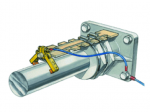Lucas Gan
Active member
Just viewed a Fairline boat in the nearby marina. I saw the shafts have electro eliminators on them. The problem is the eliminators wear the two shafts around 1-2mm depth scratches, so making a huge groove on the shaft. Is it worth it to have that eliminator on shafts? I don't feel good about the groove on the shaft. What do you think? Thank you.
I forget to take a photo. The thing is similar to the picture shown below.

I forget to take a photo. The thing is similar to the picture shown below.

Last edited:
